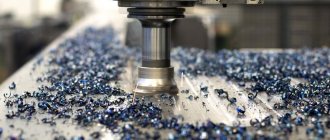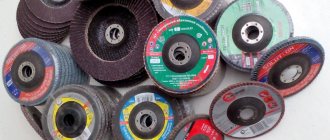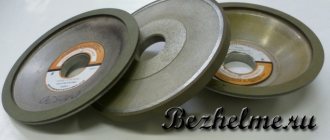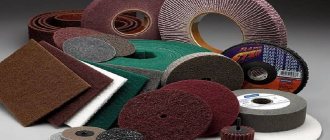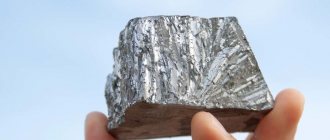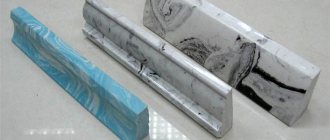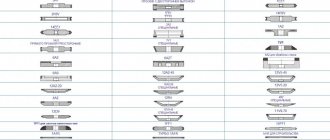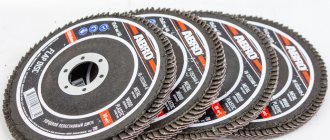Types of abrasive wheels are distinguished by design differences and are regulated by GOST R 52781-2007 “Grinding wheel”. The document defines the following types of products:
- ring;
- disc-shaped;
- conical;
- conical double-sided;
- with grooves on one or two sides;
- with a recessed central part;
- with cylindrical and conical recesses;
- with two grooves.
Image No. 1: Diagrams of abrasive wheels
Products of certain subtypes are used for different procedures: processing, grinding, tool sharpening. In this case, the main selection criterion is related to the type of workpiece being ground and the nature of the impact on its surface.
Grinding wheels with straight and annular profiles are used in domestic conditions and on compact machines for processing metal products, sharpening tools, and cutting edges. They are also suitable for working with glass, stone, porcelain, and ceramics.
Photo #1: Tapered abrasive wheels
The most popular are conical-type circles (double-sided and regular). With their help, planes are processed and recesses of various shapes are made.
Photo #2: Cup-shaped abrasive wheels
Cup-shaped and disc-shaped wheels with diamond coating are widely used. In addition to diamond abrasive, other materials are actively used for the manufacture of wheels: electrocorundum, silicon carbide, CBN, bakelite. We will tell you more about choosing attachments for cutting tools below.
Types of grinding wheels
There are 4 types of grinding discs:
- The sanding wheel is suitable for removing old paintwork. The surface of the disc looks like bristles made of metal wire. The circle is wear-resistant and rigid.
- A cord brush (twisted roller) is intended for rough grinding of materials and surfaces. The disc is perfect for removing varnish and paint from metal and wood, as well as when processing concrete.
- The end disc is designed for trimming previously sawn parts.
- The Velcro circle allows you to process stone and concrete surfaces. The discs are attached to the base using an adhesive base.
Flap discs are perfect for wood; the material has high wear resistance. The sandpaper petals are overlapping on the circle.
Application of abrasive wheels
The main area of application of abrasive wheels is cleaning surfaces made of carbon steel, cast iron, plastic, non-ferrous metals, glass, iron. The tool is also used for cutting brick, tile, slate, drywall, and concrete. Products are actively used for cutting grooves and slits of various shapes and depths.
The circles that are installed on the drill deserve special attention. Such nozzles are used during repair and finishing work to clean walls before laying tiles and applying plaster. Removing paint stains, rust and other coatings is another area where abrasives can be used.
Grinding wheel selection criteria
When choosing a wheel for a grinder, it is recommended to carefully familiarize yourself with its characteristics:
- Disc material. Marking from 12A to 16A electrocorundum is normal (characterized by heat resistance, excellent grain strength). Suitable for working with wrought iron, steel, cast iron and bronze. Marking from 22A to 25A for discs with a greater degree of coating uniformity, high hardness and self-sharpening ability. The higher the marking, the higher the hardness. Circles 52-22C and 62-64C are fragile.
- The size of the disk is standardized by GOST, where D is the outer diameter, d is the inner diameter, h is the height.
- Grain size: grain (fraction No. 200 to No. 16), powder (fraction No. 12 to No. 4), micro-grinding powder and fine micro-grinding powder (the finest grains).
- A type of disk.
- Abrasive hardness: VM1, VM2 – soft, WH – extremely hard.
- Grain binding material: R (B) vulcanite binder (rubber); V (K) – ceramic and V (B4 or BU) with artificial resins.
- The imbalance of the disk is the ratio of the mass of the circle to its shape. Class A indicates the permissibility of using the disk on high-precision equipment. Precision B is a universal disc, and circles marked AA have an ideal geometric shape.
- The structure of the disc is indicated by numbers: from 1 to 4 - dense (large amount of abrasive), 5-7 indicates an average coating density.
How to determine the grain size value?
Several standards for determining grain size make establishing this value not the easiest task. To simplify the task, a special table of grinding wheel grit size was developed. It provides the designation of grain size according to GOST 3647-80, as well as according to GOST 9206-80 (for diamond chips) and the average size of abrasive particles in microns. Thanks to this, customers can easily select the grit size of the grinding wheel with different types of product markings.
Grinding wheel grit ratio table
| Designation according to GOST 3647-80 | Designation according to GOST 9206-80 (diamond powders) | Size, microns | FEPA | |
| Designation for abrasive materials excluding flexible materials | Average size, microns | |||
| F 4 | 4890 | |||
| F 5 | 4125 | |||
| F 6 | 3460 | |||
| F 7 | 2900 | |||
| 200 | 2500/2000 | 2500-2000 | F 8 | 2460 |
| F 10 | 2085 | |||
| 160 | 2000/1600 | 2000-1600 | F 12 | 1765 |
| 125 | 1600/1250 | 1600-1250 | F 14 | 1470 |
| 100 | 1250/1000 | 1250-1000 | F 16 | 1230 |
| F 20 | 1040 | |||
| 80 | 1000/800 | 1000-800 | F 22 | 885 |
| 63 | 800/630 | 800-630 | F 24 | 745 |
| 50 | 630/500 | 630-500 | F 30 | 625 |
| F 36 | 525 | |||
| 40 | 500/400 | 500-400 | F 40 | 438 |
| 32 | 400/315 | 400-315 | F 46 | 370 |
| 25 | 315/250 | 315-250 | F 54 | 310 |
| F 60 | 260 | |||
| 20 | 250/200 | 250-200 | F 70 | 218 |
| 16 | 200/160 | 200-160 | F 80 | 185 |
| 12 | 160/125 | 160-125 | F 90 | 154 |
| F 100 | 129 | |||
| 10 | 125/100 | 125-100 | F 120 | 109 |
| 8 | 100/80 | 100-80 | F 150 | 82 |
| 6 | 80/63 | 80-63 | F 180 | 69 |
| 5, M63 | 63/50 | 63-50 | F 220 | 58 |
| F 230 | 53 | |||
| 4, M50 | 50/40 | 50-40 | F 240 | 44,5 |
| M40 | 40/28 | 40-28 | F 280 | 36,5 |
| F 320 | 29,2 | |||
| M28 | 28/20 | 28-20 | F 360 | 22,8 |
| M20 | 20/14 | 20-14 | F 400 | 17,3 |
| M14 | 14/10 | 14-10 | F 500 | 12,8 |
| M7 | 10/7 | 10-7 | F 600 | 9,3 |
| M5 | 7/5 | 7-5 | F 800 | 6,5 |
| M3 | 5/3 | 5-3 | F 1000 | 4,5 |
| 3/2 | 3-2 | F 1200 | 3,0 | |
| 2/1 | 2-1 | F 1500 | 2,0 | |
| F 2000 | 1,2 | |||
| 1/0 | 1 and | |||
| 1/0,5 | 1-0,5 | |||
| 0,5/0,1 | 0,5-0,1 | |||
| 0,5/0 | 0.5 and | |||
| 0,3/0 | 0.3 and | |||
| 0,1/0 | 0.1 and | |||
To select the optimal grinding disc grit value, you must take into account:
- the amount of allowance removed,
- specified surface roughness and other factors.
For example, if it is necessary to reduce the surface roughness, then you will need to choose a wheel with a smaller grain size. It is not always advisable to choose a wheel with too fine a grain, since in this case the material being processed may be burned and the wheel itself may become greasy. We should not forget that the use of a wheel with fine grain entails a decrease in the productivity of mechanical processing of the material.
The best velcro sanding discs
Makita P-43533 with Velcro from the famous Japanese company allows you to quickly change disks during operation.
- Users note the high-quality Velcro that securely fastens the disk.
- The high density of the abrasive coating allows the wheel to be used for a long time, and the holes in the disk quickly remove dust from the coating being sanded.
The German power tool brand offers the Hammer 214-012 with a durable fabric base.
- The disc has high flexibility and wear resistance characteristics.
- The water-repellent coating keeps the circle from getting wet.
- The coating grit is P400, the artificial resin reliably binds the abrasive material.
- Aluminum grains are capable of self-sharpening during operation.
Wolverine 435150, made in China, is characterized by high performance. Grit P150. Its versatility and low cost make Wolverine one of the best brands of velcro sanding wheels.
Abrasive disc size
The marking of abrasive wheels by size is written as follows: DхТхН (where D is the outer diameter, T is the height, H is the diameter of the hole). The D parameter can reach a maximum size of 1100 mm, the H value can be up to 305 mm, and the T parameter varies from 0.18 mm to 250 mm.
The types of CBN and diamond discs are described in more detail in GOST 24747-90. The marking of the shape of such grinding wheels consists of three or four symbols indicating the cross-sectional shape of the body and layer, its location on the wheel, and also provides information about the design features of the body.
For example, 150x16x32 is the size of a 25A white electrocorundum abrasive wheel.
Reminder when choosing abrasive wheels:
- When choosing the diameter of the circle, you should take into account the number of spindle revolutions and the ability to provide optimal speed.
- The larger the diameter, the less specific wear of the circle. There are fewer grains on the working surface of small circles. So, during operation they wear out unevenly.
- When choosing a diamond wheel, you should take into account the width of the diamond-bearing layer. If used incorrectly, ledges may appear on the surface of the wheel.
This is interesting: Cold metal stamping: technology, types, equipment
Best Sanding Discs (Bolt-On)
- Model 3M 57018 is distinguished by reliable fixation and increased strength. The sanding disc is suitable for long-term use under intense loads. The design of the abrasive is three-dimensional, so the disc does not deform even during high-speed rotations of the wheel. The model is characterized by increased wear resistance, elasticity and the ability to cool quickly.
- Stayer 36228-150-6.0 is made using multilayer reinforcement technology (fiberglass mesh). The disc is characterized by a long service life, strength and resistance to deformation. Aluminum grains can be used when the circle rotates over 10 thousand revolutions per minute. Stayer perfectly cleans welds and removes burrs from metal.
- ZUBR 36204-150-6.0 z02 is also produced using the reinforcement method (polyamide mesh). The grinding disc is highly durable and ready for intensive work for a long time. Abrasive – aluminum oxide. However, the grinding wheel is only suitable for rough processing of materials.
Abrasive compositions used
The initial requirements according to GOST are resistance to frictional wear (and under the combined action of high pressures and sliding speeds), low thermal conductivity and increased surface hardness.
Depending on the intensity of use, GOST 28818 allows the use of the following materials:
- Electrocorundum with a bauxite component, the basis of which is high-percentage aluminum oxide Al2O3 with the addition of calcium oxide. This chemical compound is characterized by increased hardness, which is also maintained at high temperatures occurring in the grinding or straightening zone. Marking of electrocorundum circles - from 12A...15A for normal, to 22A...25A for white. As the index increases, the strength of the wheel increases due to an increase in the hardness of the base substance.
- Electrocorundum on a carbide basis. Most often it contains carbides of chromium, titanium, zirconium and silicon. Marking starts from 38A (for zirconium) and ends at 95A (for chromium and titanium). Carbides of these metals have increased resistance to shear shear stresses, and therefore are suitable for removing surface layers of parts that have undergone heat treatment, or for straightening them. The presence of silicon carbide (marked 52C...65C) increases resistance to temperature changes.
- Spherocorundum is a material that is obtained by blowing molten aluminum oxide, resulting in the final spherical shape of the grains (in electrocorundum the grains are predominantly flat). This composition is labeled ES, and it is characterized by extremely high hardness. This circumstance allows the use of spherocorundum for grinding materials of increased hardness, including even hard alloys.
- Monocorundum (marking - 43A...45A), where the grinding grain, unlike other types, has a monocrystalline structure. This increases the durability of the abrasive composition, but at the same time increases its cost, since the technology for growing single crystals is very complex. A more accessible variety is aggregated monocorundum, which combines poly and monocrystalline sections in a certain way.
The degree of grain size is established in accordance with GOST 3647, and is also noted in the marking.
The abrasive component is fastened to the base using rings, flanges, fiberglass discs, etc.
TOP 3 flap discs for grinding
In the Bosch X-Lock X571 grinding wheels, the petals are based on an abrasive made of zirconium and aluminum.
- The material is perfect for long-term and intensive work with metal.
- The X-Lock disc mounting system makes it easy to change the disc during operation.
- Among the “advantages” of the model, it is necessary to note the solid base and reinforced design of the petals.
- Bosch will help you sand metal easily, even when working with heavy loads.
The Russian Master PM90337 is more difficult to install, but it has proven itself well even when operating at speeds over 13 thousand rpm.
- The base of the circle is made of fiberglass, which ensures the material's resistance to wear.
- The design of the petals ensures comfortable operation.
- Zirconium oxide is used as an abrasive material, which does not overheat and is not afraid of abrasion.
- Professionals recommend using the Russian Master grinding wheel when working with aluminum, brass, and bronze.
Dronco 5211384 consists of cotton and polyester, which indicates the flexibility and durability of the material.
- The grinding disc is based on a glass mesh, which allows the wheel to be used under heavy loads.
- Dronco does not leave scratches, so the circle is used for decorative work. Recommended for the final stage of sanding.
By studying the characteristics of various grinding wheels, you can easily choose the ideal disc at an affordable cost.
Professionals recommend carefully studying the description of grinding wheels and selecting the right material for certain types of work.
Grit assignment table
| Grit numbers according to GOST 3647-80 | Grit numbers according to GOST R 52381-2005 | Purpose |
| 125; 100; 80 | F14; F16; F20; F22 | Dressing of grinding wheels; manual roughing operations, cleaning of blanks, forgings, welds, castings and rolled products. |
| 63; 50 | F24; F30; F36 | Preliminary round external, internal, centerless and flat grinding with surface roughness of 5-7 cleanliness classes; finishing of metals and non-metallic materials. |
| 40; 32 | F40; F46 | Preliminary and final grinding of parts with surface roughness of 7-9 classes of cleanliness; sharpening cutting tools. |
| 25; 20; 16 | F54; F60; F70; F80 | Finish grinding of parts, sharpening of cutting tools, preliminary diamond grinding, grinding of shaped surfaces. |
| 12; 10 | F90; F100; F120 | Diamond finishing grinding, sharpening of cutting tools, finishing grinding of parts. |
| 8; 6; 5; 4 | F150; F180; F220; F230; F240 | Finishing of cutting tools, thread grinding with fine pitch threads, finishing grinding of parts made of hard alloys, metals, glass and other non-metallic materials, fine honing. |
| M40-M5 | F280; F320; F360; F400; F500; F600; F800 | Final finishing of parts with an accuracy of 3-5 microns or less, roughness of 10-14 cleanliness classes, su |
The choice of grinding disc is also determined by the nature of the work performed; using this abrasive tool you can perform the following operations:
- dressing of grinding wheels;
- peeling operations;
- cleaning of forgings and welds;
- finishing of the cutting tool;
- thread grinding operations;
- preliminary and final grinding;
- final finishing of the part.
Each of the above operations has a certain cleanliness class, which must also be taken into account when choosing the grain size of the grinding disc.
You can buy these products on the products page
